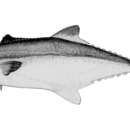Diagnostic Description
provided by Fishbase
Interpelvic process small and bifid. Lateral line gradually curving down toward caudal peduncle. Vertebrae 20-21 precaudal plus 34-36 caudal, total 54-56. Intestine with 2 folds and 3 limbs. Swim bladder absent. Body covered with small scales. First dorsal fin black anteriorly and along distal edge posteriorly. Has the most number of vertebrae and anal fin rays in the genus. Sides silvery without spots, blotches or bars.
Migration
provided by Fishbase
Oceanodromous. Migrating within oceans typically between spawning and different feeding areas, as tunas do. Migrations should be cyclical and predictable and cover more than 100 km.
Morphology
provided by Fishbase
Dorsal spines (total): 16 - 19; Dorsal soft rays (total): 21 - 25; Analspines: 0; Analsoft rays: 25 - 29; Vertebrae: 54 - 56
Biology
provided by Fishbase
Neritic species found in turbid waters. Sexual maturity is attained at much less than 30 cm fork length. The smallest species in the genus.
Importance
provided by Fishbase
fisheries: minor commercial; gamefish: yes; price category: very high; price reliability: questionable: based on ex-vessel price for species in this genus
Papuan seerfish: Brief Summary
provided by wikipedia EN
The Papuan seerfish (Scomberomorus multiradiatus) also called the Papuan Spanish mackerel, is a species of fish in the family Scombridae. It is endemic to the Gulf of Papua off the mouth of the Fly River. It is the smallest species in the genus Scomberomorus. Sexual maturity is attained at much less than 30 cm fork length.
- license
- cc-by-sa-3.0
- copyright
- Wikipedia authors and editors

